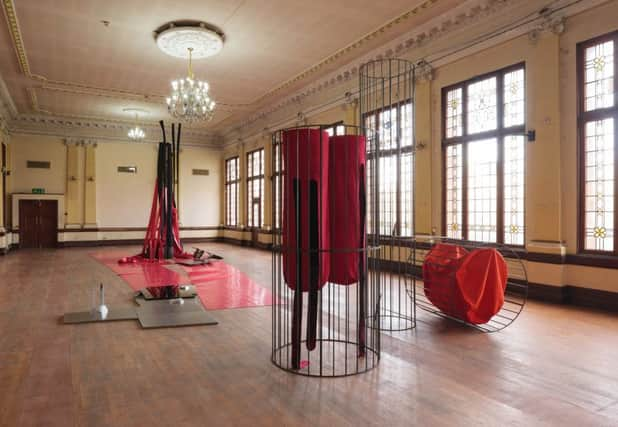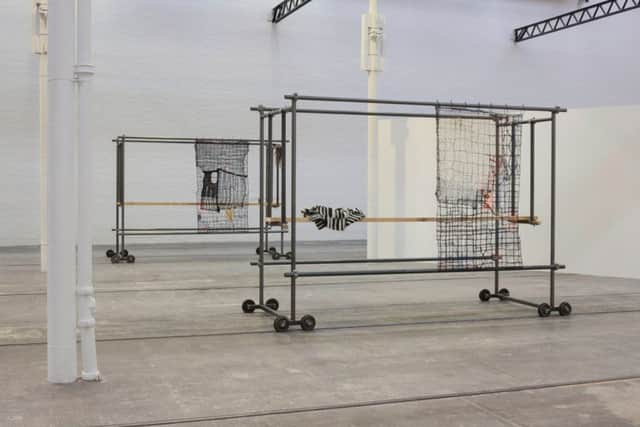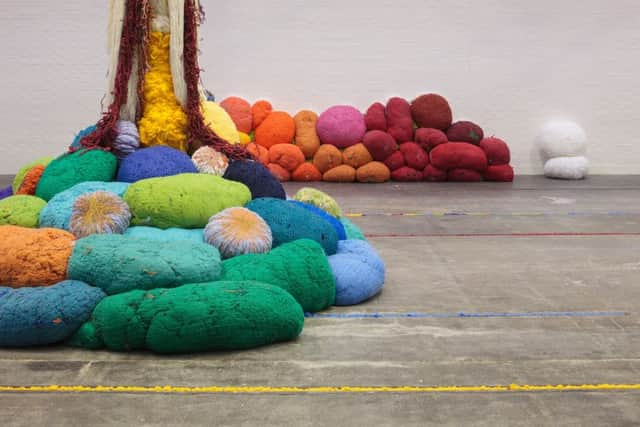Art review: Glasgow International, Glasgow


Ibegan the opening night of the Glasgow International Festival 2016 in the art deco splendour of the bar at Rogano. I finished up in a small industrial estate in Maryhill, at a low-key and lovely exhibition. It was entitled Human Shaped (***) and set in a temporary artist-led gallery set up at Sculpture and Design, the fabricators who help some of the city’s most prominent artists realise technically complex works.
One bar was the lacquer and chrome, the product of an era when Glasgow was the workshop of the world and it’s rich folk styled their leisure palaces to look like the great ocean-going liners made by John Brown of Clydebank. The other was constructed from ply, where I drank wine out of a plastic cup surrounded by tools of the trade in the new Glasgow: the workshop of the art world.
Advertisement
Hide AdAdvertisement
Hide AdAt least, I think that’s the script that has been unfolding these last few days. There is a confusion I think, not so much in the curation of this year’s Glasgow International but in its wider reception. The curated programme of the bi-annual visual arts festival began as an exploration of the legacy of manufacture and industry on art in the post-industrial era. It has, however, been seen in some parts as the triumph of the cultural economy. This is Glasgow transformed from coal-fired cultural desert into cappuccino-fuelled artistic oasis.


The centre of GI curator Sarah McCrory’s official programme is at Tramway, where the conversation she has started is undoubtedly more complex than these clichés. Here, in and untitled group show (****), the Cologne artist Alexandra Bircken’s trolleys of scaffolding pole and planks are draped in web-like weaving and bolstered by blankets. Sheila Hicks, an 82 year-old Paris-based American of considerable stature, has created a monumental assemblage of acrylic fibre balls and a waterfall of threads that pour down an industrial pillar.
Hicks trained in painting, but developed an interest in South American architecture and indigenous textiles. From her mentors Josef and Anni Albers, she inherited the European traditions of the Bauhaus. Now thought of as the epitome of form and function modernism it began with hands on making craft and the medieval model of the cathedral workshop in mind. These works examine the form and ethics of the handmade in the digital era.
At the Kelvin Hall, currently undergoing transformation as part of a new “museum quarter”, the sculptor Claire Barclay has created the sculptural installation Bright Bodies (****) in a semi-derelict lobby. It uses all of her deep and decades-long engagement with materials. Quoting the venue’s varied histories from industrial exhibitions, to circuses and athletics track, Barclay drapes thick red rubber over welded steel, and spills shiny coal tar into a tray. There is a clinical questioning in her work as well as sensuality. How do we value the machine-tooled elements of her art, against those that are handmade? Inside suspended fabrics Barclay has rubbed soot. It smells wonderful and terrible, the smell of the past.
In Bridgeton, the Albus is a glamorous new office development of pale brick and glass, polished concrete and stainless steel built for a future Glasgow that doesn’t quite exist yet. It has been borrowed for a beautiful artist-led show of sculpture and print called Semi-Gloss, Semi-Permeable (***) where Helen de Main explores labour and women’s work through prints on glass and steel. James McLardy’s monumental forms evoke the smooth pebble and ancient monolith aesthetic of early modern sculpture but use rigorously contemporary methods of construction. What happens when forms move like this, back and forth in time and place?


One of the strongest and most quietly troubling works back at Tramway is Provenance, a 40-minute film by the US artist Amie Siegel that examines the global trade in the furniture created by Le Corbusier and Pierre Jeanneret for the civic spaces of the Indian city of Chandigarh.
On the face of it Provenance is a piece of interior design porn, as we see the stylish chairs in glamorous, minimalist apartments or, in a memorable sequence, an unidentified oligarch’s superyacht. They are photographed like supermodels, appear at furniture auctions and are ripped apart and rebuilt by restorers. Much in the film goes unsaid. Is it a critique of the vacuous world of greedy rich folks who pay $42,000 for a pair of lounge chairs intended to inhabit an Indian courtroom? Does it really tell us anything about how and why these chairs are plucked from their context?
Advertisement
Hide AdAdvertisement
Hide AdYet there’s something relentless and quietly shocking in Provenance’s construction. It is about our fetishisation of objects, how they travel and the way their meaning is transformed, as well as about an unspoken subtext of global imbalance. The film closes in a dusty university lecture hall in Chandigarh. The lecture is on economics.
There are almost 80 shows at GI 2016. I’ll review a handful more of them next week, many of them housed in old industrial buildings that are now studios and workshops. The cultural economy is by no means a new development for Glasgow. It is dynamic but also fragile, and that it can’t simply replace the old industrial one is still evident across the city. Glasgow has a twin track economy: on the one hand, there is the undoubted rise of the service, tourism and financial sectors; on the other, shocking health, economic and social inequalities. Post-industrialism is a political conundrum, poverty a political disgrace. We shouldn’t be asking artists in their workshops to solve it, nor inadvertently suggesting that they have.
• Glasgow International runs until 25 April, although some shows are open for longer. See www.glasgowinternational.org for details